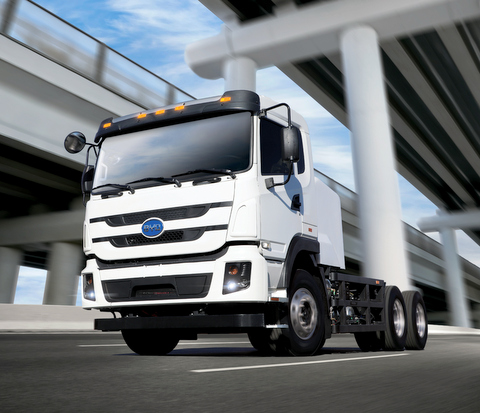Greening Manufacturers’ Supply Chains
The electric vehicle (EV) conversation typically revolves around passenger cars, but the need for electrification goes much further. Manufacturers are responsible for a considerable amount of greenhouse gas emissions, and the trucks their supply chains rely on are a bigger factor. A truly sustainable future is only possible if long-haul trucks can switch to electric powertrains.
Unfortunately, heavy-duty vehicles face unique challenges when it comes to electrification. At the same time, a green transport transition would benefit the manufacturing sector in several ways. It’s important to recognize both sides of the issue to create a roadmap for the future of sustainable freight.
Benefits of EVs in Manufacturing Transportation
The most obvious advantage of fleet electrification is it would greatly improve overall emissions. Medium- and heavy-duty trucks account for 23% of all transportation emissions, making them the second largest contributor, behind light-duty trucks like pickups and SUVs.
These larger vehicles’ relative portion of the emissions pie may rise in the future, too. As more consumers switch to EVs and logistics activity increases in response to higher demand, large trucks’ portion of the whole will grow.
Manufacturers also would experience long-term economic benefits from sustainable freight. While electrification entails high upfront costs, it reduces fuel expenditures, which account for a significant amount of fleets’ ongoing expenses. Electricity is not free, but it’s generally less volatile than diesel prices and opens the door to on-site generation.
Similarly, EVs require less maintenance than combustion engines. Consequently, manufacturers could save costs and improve vehicle uptime by switching to electric alternatives for their fleet.
There are health factors to consider, too. Air pollution contributes to more than 7 million premature deaths worldwide annually, and vehicles are a major cause of low air quality. An industry-wide shift to EVs would improve the cleanliness of the air in some regions, letting manufacturers take part in global health progress.
Recent Advances in EV Trucks
Long-haul EV trucks have yet to catch up to consumer-grade electric cars. However, several companies have made significant strides in the development of these solutions Soithin the past few years.
Volvo recently unveiled an electric truck that can travel 600 kilometers (372 miles) before recharging, with plans to sell it in the second half of 2025. While that is still far below what most diesel alternatives can achieve before refueling, it’s an impressive benchmark for EVs. It’s also more than enough to handle last-mile deliveries, middle-mile freight and other short routes, giving manufacturers a starting point for electrification.
Some freight carriers have already begun the shift to EVs. German logistics provider DHL deployed a fleet of electric trucks in 2024. The Mercedes-Benz-manufactured vehicles have a 220-kilometer range (136 miles) and a maximum weight of 19 metric tons (40,000 pounds). Like the Volvo solution, they’re not ideal for the longest deliveries, but are sufficient for last-mile shipping.
Tesla, Volkswagen, Freightliner and others are all working on long-haul EVs, too. As more of these companies come out with electric models, the increasingly diverse market will give manufacturers a wider array of options. Adoption will become more accessible as that happens.
Remaining Obstacles to Long-Haul EV Trucks
Despite these positive trends, there are still some significant roadblocks to sustainable freight. Initial vehicle costs and limited ranges are among the most prominent.
Semi-trucks often travel several hundred miles per day. Even if this means an EV must only recharge once daily, long charging times can significantly delay delivery. For EVs to become practical in most situations, ranges must increase or recharge times decrease.
EVs are also expensive, especially on such a large scale. While government incentive programs can help, recent administration trends may make these EV-promoting breaks less common or impactful. There’s still a long-term economic argument for EV’s lower operating costs, but the initial investment remains a substantial barrier.
A widespread lack of charging infrastructure presents another challenge. There are over 192,000 public charging ports across the U.S., but most are in or near large metropolitan areas and designed for light-duty vehicles. Fast chargers are even less common. While this affects consumer adoption, too, it’s a more prevalent issue for long-haul trucks, which must frequently travel through less populated regions.
How Can Sustainable Freight Move Forward?
The current barriers facing sustainable freight are imposing, but progress is possible. Pushing for government efforts to increase charging infrastructure or offer electrification incentives may be difficult in today’s climate, but technological and strategic improvements are achievable.
Adding solar panels to long-haul electric trucks could resolve some range anxiety. Current consumer models can add another 6.4 miles by incorporating rooftop solar. Applying similar systems to truck trailers — which offer more surface area for greater charging capacity — could boost ranges as battery technology advances.
Hydrogen is another zero-emission option for trucks
Looking beyond battery-electric options may be necessary. Hydrogen fuel cells are a promising alternative, as they’re even more efficient than combustion engines. A lack of hydrogen fueling infrastructure and high truck purchase costs stand in the way, but funding research and development in this area could make long-haul zero-emissions routes more attainable.
Industry-wide, dramatic changes will require additional technological advancement. Manufacturers could begin by electrifying last-mile deliveries in the meantime to reduce their emissions before technology can enable longer-travelling EVs. This slower approach may ease the cost burden, too.
EV Manufacturing Trucks Are a Lofty but Important Goal
The future of sustainable freight is uncertain, but greener manufacturing supply chains are certainly possible. It will take investment and widespread collaboration, but effort from enough parties could make zero-emissions long-haul trucks a reality. The transition will not be easy, but it’s vital for the climate, public health and organizational strength.
The post Sustainable Freight: The Future of Long-Haul EV Trucks first appeared on Clean Fleet Report.





